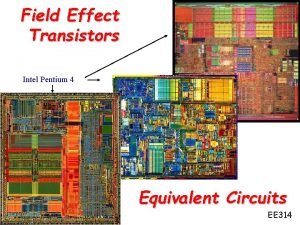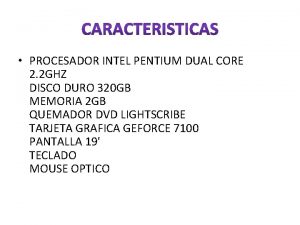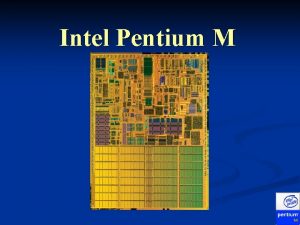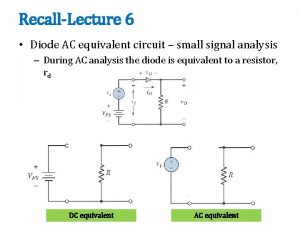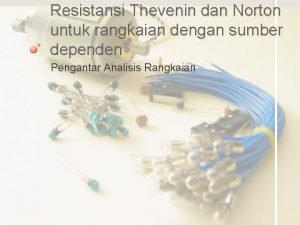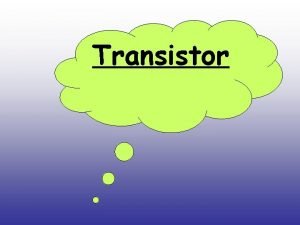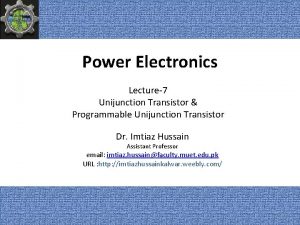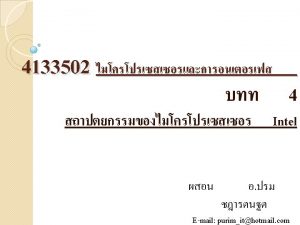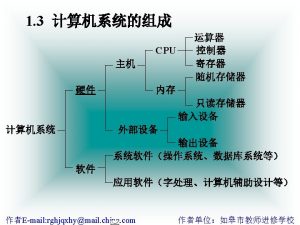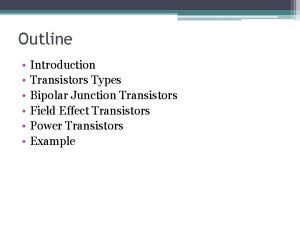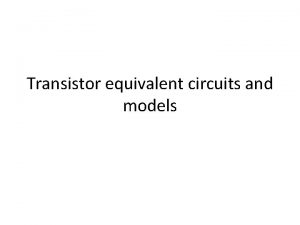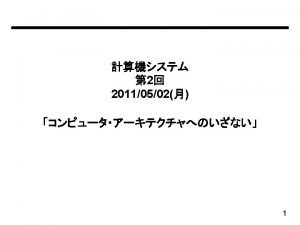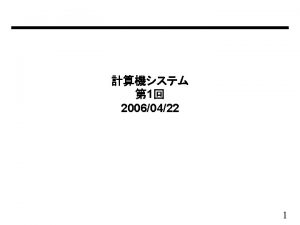Field Effect Transistors Intel Pentium 4 Equivalent Circuits
















- Slides: 16

Field Effect Transistors Intel Pentium 4 Equivalent Circuits EE 314

MOSFET Transistor 1. Small-Signal Equivalent Circuits 1. Examples 2. Technology 3. Future Devices Chapter 12: Field Effect Transistors

Current-Voltage Relations MOSFET Transistor 6 x 10 -4 VGS= 2. 5 VDS = VGS - VT Triode Saturation 4 ID (A) VGS= 2. 0 V 3 Quadratic Relationship VDS = VGS - VT 2 VGS= 1. 5 V cut-off 1 0 VGS= 1. 0 V 0 0. 5 1 1. 5 2 2. 5 VDS (V) NMOS transistor, 0. 25 mm, Ld = 10 mm, W/L = 1. 5, VDD = 2. 5 V, VT = 0. 4 V

Load-Line Analysis of NMOS Amplifier It is a graphical analysis similar to load-line analysis of pn diode. We look for the operating point Schematic v. GS v. DS Circuit Analysis: Input loop Output loop Load line

Load-Line Analysis of NMOS Amplifier Exercise: Draw the Load line RD= 1 k. W

Load-Line Analysis of NMOS Amplifier Load line Taking i. D=0 or v. DS=0 we find out the load lane and the quiescent operating point Q for VGS=4 V The quiescent values vin(t)=0 then i. DQ=9 m. A v. GSQ=4 V and v. DSQ=11 V Points A & B intersection of curve and the load -line for the maximum and the minimum gate voltage

Load-Line Analysis of NMOS Amplifier Input signal (peak-to-peak amplitude is 2 V) v. DS(t) 12 V peak-to-peak vin(t) Inverse operation The positive peak of the input occurs at the same time as the min. value of v. DS. The output is not a symmetrical sinusoid! (nonlinear distortion)

Self Bias Circuits Analysis of amplifier circuits is often undertaken in two steps: (1) The dc circuit analysis to determine the Q point. It involves the nonlinear equation or the load-line method. This is called bias analysis The fixed-plus selfbias circuit Exercise: + Find VG voltage as a function of VDD, R 1 and R 2 v. G _ Input Output

Self Bias Circuits Analysis of amplifier circuits is often undertaken in two steps: (1) The dc circuit analysis to determine the Q point. It involves the nonlinear equation or the load-line method. This is called bias analysis The fixed-plus selfbias circuit + v. G _ Input Output

Self Bias Circuits Analysis of amplifier circuits is often undertaken in two steps: (1) The dc circuit analysis to determine the Q point. It involves the nonlinear equation or the load-line method. This is called bias analysis (2) Use a linear small-signal equivalent circuit to determine circuit parameters Analysis… Equivalent circuit find v. GS v. DS

Self Bias Circuits Plot of and Disregarded root < for v. GS Vt 0 Use only larger root for v. GS and smaller for i. D Example 12. 2

Self Bias Circuits Analysis of amplifier circuits is often undertaken in two steps: (1) The dc circuit analysis to determine the Q point. It involves the nonlinear equation or the load-line method. This is called bias analysis (2) Use a linear small-signal equivalent circuit to determine circuit parameters Analysis… find i. D For saturation region Equivalent circuit v. GS v. DS

Self Bias Circuits Exercise 12. 5 Analyze the self-bias circuit shown. The transistor has KP=50 m. A/V 2, Vto=2 V, L=10 mm, and W=400 mm find v. GS find i. D find v. DS

Flexible Field Effect Transistors EE 314

Play video about plastic electronics http: //www. plasticlogic. com Q: How we can do this? A: A new generation of MOSFETs for plastic electronics

Transistor Feature Sizes http: //www. hkn. org/imgs/bridge_sp 06_figure 2. gif
 Pentium 4 transistors
Pentium 4 transistors Intel pentium 2 ghz
Intel pentium 2 ghz I7 4790k wiki
I7 4790k wiki Ia32 architecture
Ia32 architecture Intel pentium processor
Intel pentium processor Fast desktop for architecture software
Fast desktop for architecture software Superscalar architecture diagram
Superscalar architecture diagram Intel pentium
Intel pentium Paralleilism
Paralleilism Intel pentium
Intel pentium Laptop nn32 bit
Laptop nn32 bit 8088 microprocessor architecture
8088 microprocessor architecture Advantages of parallel circuits over series circuit
Advantages of parallel circuits over series circuit The ac equivalent of the diode is a resistor
The ac equivalent of the diode is a resistor Thevenin and norton equivalent circuits
Thevenin and norton equivalent circuits How pnp transistor works as a switch
How pnp transistor works as a switch Ujt in electronics
Ujt in electronics
